Abstract
The paper explores the impact of oil and gas activity on the regional social well-being for Krasnoyarsk Region in Russia. Krasnoyarsk Region is a new oil and gas producing region which has significant hydrocarbon resources and where industrial exploitation of oil and gas fields began in 2009. The paper conducts a comparative analysis of the main indicators of the regional social well-being before and after the start of oil and gas production. The results demonstrate that oil and gas activity has not resulted in a significant increase in per capita income, in employment and in provision of social services. A comparison of regional social indicators such as per capita income, inequality, Human Development Index and crime rate with national indicators revealed the same dynamics. So, changes in many indicators of social well-being in the region are due to macroeconomic and political reasons that are characteristic of the country in general rather than to the development of oil and gas production. A direct negative effect of oil and gas production is a noticeable increase in environmental damage, which negatively affects the health of the population. Thus, the development of oil and gas production did not provide significant social benefits for the region.
Keywords: Oil and gaswell-beingindicatorsregion
Introduction
In literature, there is a lively debate on the role of natural resource extraction in socio-economic development. Some researchers suggest a negative effect of natural resources on economic growth (Kronenberg, 2004; Mehrara, 2009; Sachs & Warner, 2001; Sala-i-Martin, Doppelhofer, & Miller, 2004). This phenomenon is termed the “resource curse” (Auty, 1993).Others find a positive association between natural resources and economic performance, and argue that natural resources can accelerate economic growth through various channels (Brunnshweiler, 2008; James, 2015; Michaels, 2011).Hence, the issue on the influence of natural resources on economic growth remains indeterminate.
However, the growth rate of gross domestic product is not the only important indicator of socio-economic development. The focus of socio-economic development should be on the satisfaction of human needs. Unfortunately, economic growth does not always lead to improved social well-being. Therefore, indicators of social well-being are also essential.
The concept is now widespread that natural resources are a public welfare (Segal, 2012). Therefore, all citizens should receive benefits from the extraction of natural resources. The benefits are especially important for residents of regions where natural resources are located, since they bear the main environmental and social damages from mining. Thus, the impact of natural resource extraction on social well-being deserves more attention.
The paper contributes to literature considering the effects of oil and gas activity on the key indicators of regional social well-being.
Problem Statement
In theory, oil and gas activity should improve social well-being by increasing employment, income per capita and public services and those reduce poverty. However the results of various studies on the impact of natural resource extraction on social well-being are mixed. Many researchers find a positive association between natural resource extraction and both employment and per capita income. For example, Marchand (2012) estimates for Western Canada that every ten jobs in oil and gas sector create 2.9 additional jobs in construction, 2.0 additional jobs in retail trade and 4.6 additional jobs in services. Michaels (2011) detects a positive correlation between oil production and local employment and per capita income for oil abundant counties in the Southern United States. In contrast, Haggerty, Gude, Delorey, and Rasker (2014) argue that long-term oil and gas specialization has a negative effect on per capita income for the Western United States. Some researchers also believe that mineral resource extraction can exacerbate poverty through different mechanisms (Deaton & Niman, 2012; Hilson, 2012; Pegg, 2006).
Lagos and Blanco (2010) find some positive social effects of copper production for the region of Antofagasta. Rawashdeh, Cambell, and Titi (2016) investigate the case of the Southern Region in Jordan and suggest that resource development has no significant social effects for the Region.
For Russia, Belousova (2015) compares some social indicators in resource-based and non-resource regions and concludes that in resource-based regions, social well-being is worse than in non-resource regions.
Thus, the effects of natural resource extraction on social well-being are ambiguous. Results vary across countries and regions. Therefore, the problem of assessing the social effects of extractive activity, and increasing social benefits for regions, requires further research. This problem is especially important for resource-based regions where mining industry is the main and often the only sector of the economy.
Research Questions
The paper seeks to answer two research questions: (i) what indicators of social well-being in the region have improved since oil and gas production started and (ii) what negative social effects oil and gas production has.
Purpose of the Study
The purpose of the paper is to study the effects of oil and gas activities on the regional social well-being for Krasnoyarsk Region in Russia. Krasnoyarsk Region was chosen because it is a new oil and gas producing region, where the industrial exploitation of oil and gas fields began in 2009. Therefore, the necessary data are available to compare the main indicators of social well-being before and after oil and gas production.
Research Methods
Literature examines the impact of natural resources on social well-being using different indicators. Mancini and Sala (2018) review different studies and make a complete list of typical indicators assessing social impact of mining sector. This list includes 28 indicators.
Based on the available data, I selected the most important indicators that adequately characterize the social well-being of the region. These indicators are employment, per capita income, poverty rate, social inequality, provision of social services, incidence rate, and crime rate.
I also calculated the Human Development Index for 2007 and 2018 which is an important indicator of social well-being, but official statistics do not contain this indicator.
To assess the impact of oil and gas activity on social well-being, I analysed the dynamics of social indicators and conducted their comparative analysis before and after oil and gas production.
The paper used the data of the Federal State Statistics Service of Krasnoyarsk Region, Republic of Khakassia and Republic of Tyva and the data of the Federal State Statistics Service for the period 2007–2018. All value indicators I converted to constant 2007 prices. I chose 2007 as the base year for comparison, since this is the year before the start of oil and gas production.
To test whether changes in social indicators are associated with increased oil and gas production or are due to macroeconomic and political factors, I compared such regional indicators as per capita income, social inequality, poverty and crime rates, Human Development Index with those for the country in general.
Findings
Krasnoyarsk Region is a new oil and gas producing region. Proven oil resources are estimated at 875 million tons. Natural gas resources are 1181.8 billion cubic meters. Oil and gas fields are mainly located in the northern territories of Krasnoyarsk Region. Oil and gas production started in 2009 with the industrial exploitation of the Vankor field. In 2016, oil and gas production began at the Suzunskoye and the Yurubcheno-Tokhomskoe fields. Until 2009, oil production was not significant and amounted to less than 100 thousand tons per year. In 2009, 3790.3 thousand tons of crude oil were extracted. In 2018, oil production reached 24632 thousand tons. Natural gas production increased 12.5 times from 756.3 million cubic meters in 2007 to 9459.1 million cubic meters in 2018. As a result, the share of the mining sector in the gross regional product increased from 4.4 % in 2007 to 21.2 % in 2018.
The development of the oil and gas sector was expected to improve social well-being in the region through increasing employment, income per capita, and public services.
From 2007 to 2018, the oil and gas sector created 29 thousand new jobs. However, the overall employment rate declined from 63.8 % in 2007 to 54.1 % in 2018 in the region. Nevertheless, it should be noted an increase in employment in oil and gas producing municipalities. In Turukhansky municipality, the number of employees increased by 4.3 thousand over the period of oil and gas production. In Evenki municipality, the number of employees increased by 3 thousand. However, the increase in employment in the producing municipalities was much less than the number of new jobs in the oil and gas sector, because a large proportion of the sector’s workers come from outside the region.
In Krasnoyarsk Region, real per capita income from 2007 to 2018 increased by 9.7 %, while in Russia, this indicator increased by 15 %. The dynamics of per capita income in Krasnoyarsk Region was the same as in the country in general (Figure
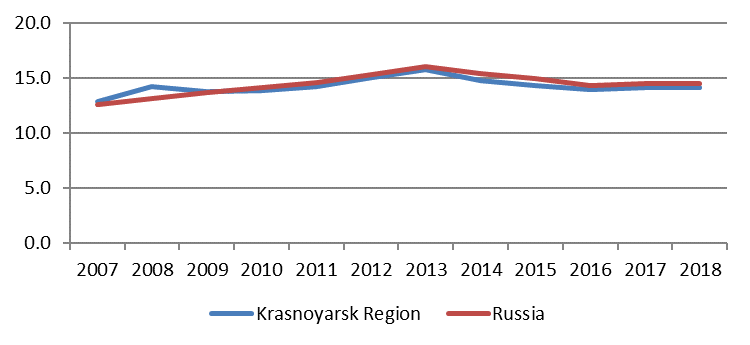
Thus, the increase in oil and gas production did not significantly affect the per capita income of the population.
Moreover, Figure
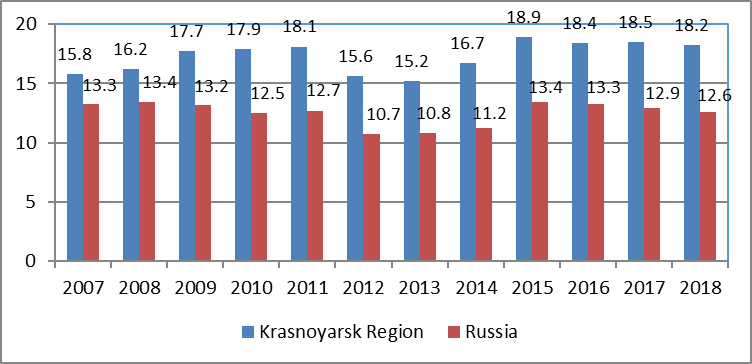
Social inequality tends to reduce in Krasnoyarsk Region. The Gini coefficient declined from 0.435 to 0.386 during the period 2007–2018. However, we cannot argue that the reduction in social inequality is associated with oil and gas production, since there is a similar trend in the country in general. However, in Krasnoyarsk Region, the reduction in inequality was much and income distribution became more equal than in Russia.
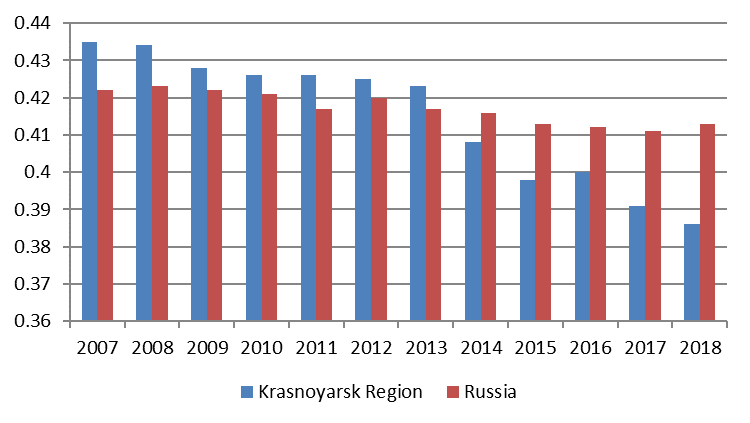
The living standards of the population in the region are also determined by the provision of social services such as education, healthcare and support for socially vulnerable population. Therefore, I analysed the regional budget expenditures per capita on social services for the period 2007–2018. Over this period, the budgetary expenditures on health care, physical education and sports more than doubled the expenditures on social policy increased by 76.8 % and the expenditures on education increased by 27.9 % (Figure
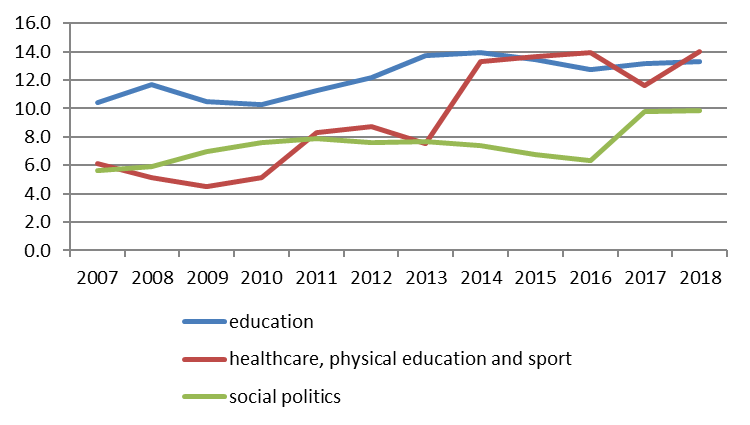
A direct negative effect of the increase in the region's oil and gas production is environmental damage. As Figure
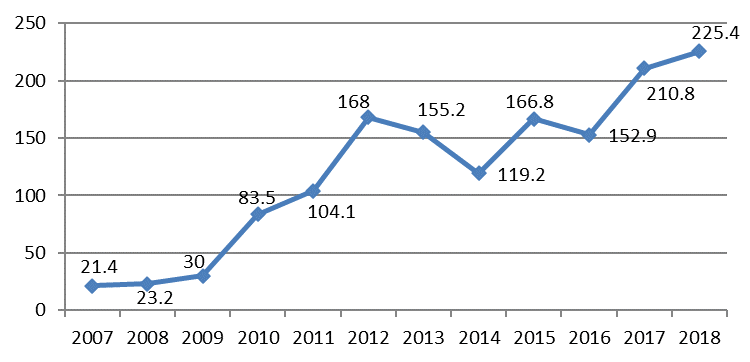
These air pollutant emissions can harm the health of the population. Over the study period, in Krasnoyarsk Region, despite the decrease in the overall incidence rate, there was the increase in the incidence of diseases such as endocrine and metabolic disorders, respiratory diseases, circulatory system diseases, neoplastic diseases (Figure
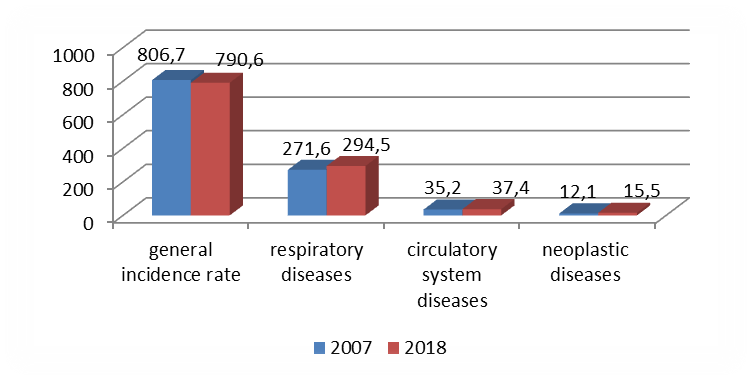
Literature provides evidence that the extraction of natural resources can cause social tensions, social conflicts, and the increase in crime (Haggerty et al., 2014; James & Smith, 2017). I am not aware of social conflicts in the region related to oil and gas activity. Also, Figure
However, the decrease in regional crime is due to the stabilization of the economic and political situation in the country rather than the development of the regional oil and gas sector, as Russia in general also has a downward trend in crime.
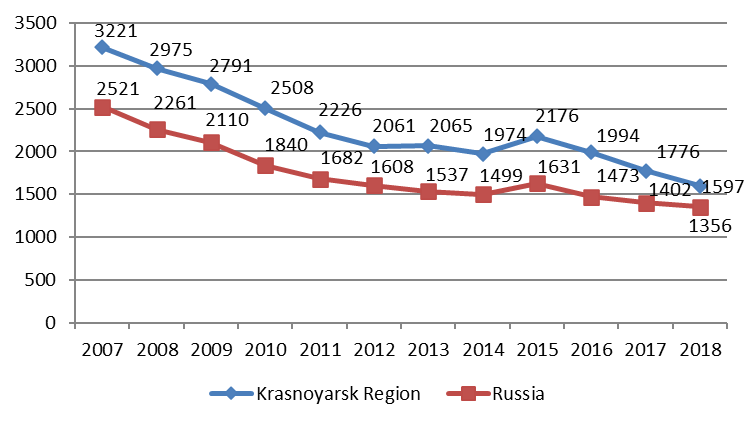
Finally, I calculated the Human Development Index (HDI), which is the general indicator of social well-being. The Table
Thus, we can conclude that the increase in oil and gas production did not have significant social effects for Krasnoyarsk Region.
Conclusion
The paper studies the influence of oil and gas production on the regional social well-being for Krasnoyarsk Region in Russia. From 2007 to 2018 in Krasnoyarsk Region, crude oil production increased 319 times and natural gas production increased 12.5 times.
The analysis shows that oil and gas activity did not significantly improve the social well-being in the region. Changes in such social indicators as per capita income, social inequality, and the Human Development Index are more likely associated with general macroeconomic and political reasons, since they have the same dynamics as those for the country overall.
However, there is no sufficient evidence for the resource curse in Krasnoyarsk Region. An obvious negative effect of oil and gas production is environmental damage, which may have led to the increase in the incidence of certain diseases.
Thus, exploitation of natural resources per se do not assure an improvement in social well-being and the state policy is required to avoid the resource curse and to increase positive socio-economic effects of oil and gas activity.
Acknowledgments
The research was carried out with the plan of research work of IEIE SB RAS, project XI.174. 1.1. «Economy of Siberia and its regions with external and internal challenges and threats: methods, trends, forecasts », № АААА-А17-117022250133-9.
References
- Auty, R. (1993). Sustaining Development in Mineral Economies: The Resource Curse Thesis. London: Routledge.
- Belousova, S. V. (2015). Resource regions: economic opportunities and financial justice. ECO, 6, 40–48. Retrieved from: http:// doi.org/
- Brunnshweiler, C. (2008). Cursing the blessing? Natural resource abundance institutions and economic growth. World Development, 36(3), 399–419. Retrieved from:
- Deaton, B., & Niman, E. (2012). An empirical examination of the relationship between mining employment and poverty in the Appalachian region. Applied Economy, 44(3), 303–312. Retrieved from:
- Haggerty, J., Gude, P. H., Delorey, M., & Rasker, R. (2014). Long-term effects of income specialization in oil and gas extraction: The U.S. West, 1980-2011. Energy Economy, 45, 186–195. Retrieved from:
- Hilson, G. (2012). Poverty traps in small-scale mining communities: the case of sub-Saharan Africa. Canad. Journal of Development Studies, 33(2), 180–197. Retrieved from: http:// doi.org/
- James, A. (2015). The resource curse: A statistical mirage? Journal of Development Economy, 114, 55–63. Retrieved from: http:// doi.org/
- James, A., & Smith, B. (2017). There will be blood: crime rates in shale-rich US counties. Journal of Environmental Economy and Management, 84, 125–152. Retrieved from: http:// doi.org/
- Kronenberg, T. (2004). The curse of natural resources in the transition economies. The Economy of Transit, 12(3), 399–426. Retrieved from:
- Lagos, G., & Blanco, E. (2010). Mining and development in the region of Antofagasta. Research. Policy, 35, 265–275. Retrieved from:
- Mancini, L., & Sala, S. (2018). Social impact assessment in the mining sectors: Review and comparison indicators frameworks. Research Policy, 57, 98–111. Retrieved from:
- Marchand, J. (2012). Local labor market impacts of energy boom-bust-boom in Western Canada. Journal of Urban Econ., 71, 165–174. Retrieved from:
- Mehrara, M. (2009). Reconsidering the resource curse in oil-exporting countries. Energy Policy, 37(3), 11 5 46. Retrieved from:
- Michaels, G. (2011). The long term consequences of resource-based specialization. The Economy Journal, 3, 31–573. Retrieved from:
- Pegg, S. (2006). Mining and poverty reduction: transforming rhetoric into reality. Journal of Cleaner Production, 14, 376–387. Retrieved from:
- Rawashdeh, R., Cambell, G., & Titi, A. (2016). The socio-economic impacts of mining on local communities: The case of Jordan. The Extractive Industries and Society, 3, 494–507. Retrieved from: https://doi.org/10.1016/j.exis.2016.02.001
- Sachs, J. D., & Warner, A. M. (2001). Natural resources and economic development: the curse of natural resources. Europ. Econ. Rev., 45, 827–838.
- Sala-i-Martin, X., Doppelhofer, G., & Miller, R. I. (2004). Determinants of long-term growth: a Bayesian averaging of classical estimates (BACE) approach. Amer. Econ. Rev., 94(4), 813–835. Retrieved from:
- Segal, P. (2012). How to spend it: Resource wealth and the distribution of resource rents. Energy Policy, 51, 340–348. Retrieved from:
Copyright information

This work is licensed under a Creative Commons Attribution-NonCommercial-NoDerivatives 4.0 International License.
About this article
Publication Date
07 December 2020
Article Doi
eBook ISBN
978-1-80296-095-2
Publisher
European Publisher
Volume
96
Print ISBN (optional)
-
Edition Number
1st Edition
Pages
1-833
Subjects
Management, human resources, resource efficiency, investment, infrastructure, research and development
Cite this article as:
Nagaeva, O. S. (2020). Oil And Gas Activity And Regional Social Well-Being. In A. S. Nechaev, V. I. Bunkovsky, G. M. Beregova, P. A. Lontsikh, & A. S. Bovkun (Eds.), Trends and Innovations in Economic Studies, Science on Baikal Session, vol 96. European Proceedings of Social and Behavioural Sciences (pp. 417-425). European Publisher. https://doi.org/10.15405/epsbs.2020.12.55

